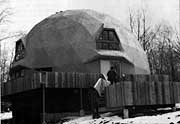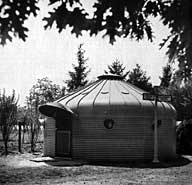Domes, dymaxions, trailers and modular homes are part of prefab housing history exhibit at Mann Library
By Susan S. Lang

"Who knew that in his spare time Thomas Edison dreamed up a single-pour concrete house? Or that before introducing the country to geodesic domes Buckminster Fuller had designed two radically different prefabs, one of them created from a grain bin?"
So said Mann Library's Ashley Miller, who curated "Fast and Affordable: A Century of Prefab Housing," the featured display at the library until mid-May.
The exhibit was inspired by Professor of Design and Environmental Analysis Jan Jennings, who wrote "Cheap and Tasteful Dwellings: Design Competitions and the Convenient Interior, 1879-1909," and whose book talk Feb. 23 (which can be viewed via an iPod or as a Webcast at http://www.mannlib.cornell.edu/computing/podcast/) coincided with the exhibit opening. Miller said that the combination of affordable housing and innovative design in that book suggested prefabs.
"Part of the American dream has always been owning your own home, and the notion that owning your own home could be both fast and affordable has great appeal," she said
From the experimental designs by Thomas Edison and Buckminster Fuller to 21st century neighborhoods of retrofitted shipping containers that have "living areas that slide in and out like vertical drawers" and can be closed up for easy transport to a new location, the exhibit traces the historical aspects of technology, labor, government policy, transportation and social and political movements that have impacted prefab housing for the past hundred years in the United States.

Through the decades, public policy-makers, builders, architects and engineers have worked on promoting the idea that efficient mass production methods could provide prefabricated affordable housing for the masses. Prefab houses don't require the labor-intensive process that conventional home building does, because many "mail order" homes use standardized designs and precut parts.
Perhaps the most triumphant prefab is the ubiquitous mobile home: "As popular as it is unpopular, [the mobile home] must be considered the most successful of all prefabricated homes -- by the year 2000, there were nearly 9 million of them in this country," Miller said. These days, many builders and homeowners use modular housing kits, which are prefabricated units that are trucked to a home site and then put together.
"In our global economy the very symbol of globalization, the 40-foot shipping container, becomes a home to suit a modern nomad, here today, Hong Kong tomorrow," Miller said.
And, of course, prefabs today also play a critical role in housing victims of natural disasters, from the tsunami in South and Southeast Asia and the victims of Hurricane Katrina to the mountain villages of Pakistan devastated by an earthquake and the highlands of Guatemala where mudslides wiped out entire villages.
Media Contact
Get Cornell news delivered right to your inbox.
Subscribe